|
|
United Nations Convention on the Law of the Sea
Montego Bay, 10 December 1982
- Introductory Note
- Procedural History
- Documents
- Status
- Video
- Photo
- Presentation
By Tullio TrevesJudge of the International Tribunal for the Law of the Sea
Professor at the University of Milan, Italy
The United Nations Convention on the Law of the Sea was opened for signature at Montego Bay, Jamaica, on 10 December 1982. It entered into force on 14 November 1994 and is presently binding for 154 States, as well as the European Community (as of 24 July 2008). It is considered the “constitution of the oceans” and represents the result of an unprecedented, and so far never replicated, effort at codification and progressive development of international law. The more than 400 articles of the text and of the nine annexes that are an integral part of it are the most extensive and detailed product of codification activity States have ever attempted and successfully concluded under the aegis of the United Nations.
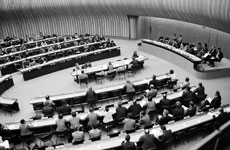 The historic circumstances that brought about the decision to engage in this codification endeavour are complex. They consist, on one side, in a process within the United Nations General Assembly concerning a specific aspect of the law of the sea, and, on the other side, in momentous changes in the structure of international society and in the uses of the sea. These two aspects merged in the decision taken by the General Assembly in 1970 (resolution 2750 (XXV) of 17 December 1970) to hold the Third United Nations Conference on the Law of the Sea. The historic circumstances that brought about the decision to engage in this codification endeavour are complex. They consist, on one side, in a process within the United Nations General Assembly concerning a specific aspect of the law of the sea, and, on the other side, in momentous changes in the structure of international society and in the uses of the sea. These two aspects merged in the decision taken by the General Assembly in 1970 (resolution 2750 (XXV) of 17 December 1970) to hold the Third United Nations Conference on the Law of the Sea.
The process within the United Nations General Assembly started in 1967 with the well known speech of the Maltese Ambassador Arvid Pardo. It focused on the mineral resources of the seabed beyond the limits of national jurisdiction, in particular the polymetallic nodules found at great depths and whose exploitation seemed to promise substantial economic benefits, which in his view were to be proclaimed the common heritage of mankind. The key concepts emerging from this process, conducted in the United Nations “Seabed” Committee, a committee set up in 1967 and continued, under different names, up to 1973, are synthesized in General Assembly resolution 2749 (XXV) of 17 December 1970 according to which the seabed and ocean floor, and the subsoil thereof, beyond the limits of national jurisdiction (the Area), as well as its resources “are the common heritage of mankind”. No State can claim or exercise sovereignty or sovereign rights thereupon, and their use shall be for peaceful purposes only. No exploration for or exploitation of these resources may be conducted outside the “international regime”, including an “appropriate international machinery”, to be established “by an international treaty of a universal character, generally agreed upon”.
The structural changes in international society consisted mainly in that, during the decade preceding Ambassador Pardo’s speech, the number of independent States had doubled. This brought to the fore a sense of mistrust for the then existing rules of international law, confirmed by the fact that the 1958 Geneva Conventions on the Law of the Sea, which had been adopted less that ten years before and had just entered into force, did not attract the ratification or accession of most of the newly independent States. For most of these new States the priorities in the uses of the seas were different than those of the maritime powers that had dominated the scene in Geneva. Exploitation of the living and non-living resources was seen as more important than, or as important as, navigation of merchant and military fleets. A claim for exclusive or sovereign rights over an area of the sea well beyond the territorial sea, previously put forward only by South American States, gained wide acceptance. At the same time, the need to protect the marine environment, after the 1972 United Nations Stockholm Conference on the Human Environment, and the conclusion of significant specific conventions (the London Dumping Convention of 1972 and the MARPOL convention of 1973) became a broadly accepted objective. Similarly, the awareness that the development of scientific research and of other marine activities fostered by technological progress and economic need required clear and generally accepted rules became widespread. This led to the recognition, in the above quoted resolution 2750 (XXV), “that the problems of ocean space are closely interrelated and need to be considered as a whole”. The merger of the two trends was so accomplished.
 The Third United Nations Conference on the Law of the Sea was convened with a broad agenda including items covering all aspects of the law of the sea, from the traditional ones to the newly emerging ones, such as the common heritage principle, the expansion seawards of the coastal States’ jurisdiction and the protection of the marine environment. After a short procedural session in New York in 1973, the Conference started its substantive work in Caracas in 1974 on the basis of a multi-volume report of the Seabed Committee, without the benefit of the previous work of experts, such as that of the International Law Commission (as in the case of the 1958 Conventions), and without a basic draft. The rule of procedure in fact followed, only in part reflected in the formal rules adopted, was that decisions were to be taken by consensus and that, in order to obtain consensus, a “package deal” approach was to be followed on every issue, on groups of issues and on all issues as a whole. Voting would be admitted only if all efforts at consensus were recognized as being exhausted. This procedure was at the same time necessary and lengthy. It was necessary because of the need to reconcile divergent interests only partially represented by the traditional groups of States (Western industrialized States, Socialist States, Group of 77, etc.), such as those of coastal States, maritime States, archipelagic States, landlocked States, land-based producers of the minerals to be extracted from the nodules, etc. It was lengthy, extending the Conference up to 1982, because it involved the reconciliation of the interests of groups as well as of particular States in such a way that each party involved could perceive even in specific provisions not consonant to its desiderata a part of a package that, as a whole, it could consider to bring more advantages than disadvantages. The Third United Nations Conference on the Law of the Sea was convened with a broad agenda including items covering all aspects of the law of the sea, from the traditional ones to the newly emerging ones, such as the common heritage principle, the expansion seawards of the coastal States’ jurisdiction and the protection of the marine environment. After a short procedural session in New York in 1973, the Conference started its substantive work in Caracas in 1974 on the basis of a multi-volume report of the Seabed Committee, without the benefit of the previous work of experts, such as that of the International Law Commission (as in the case of the 1958 Conventions), and without a basic draft. The rule of procedure in fact followed, only in part reflected in the formal rules adopted, was that decisions were to be taken by consensus and that, in order to obtain consensus, a “package deal” approach was to be followed on every issue, on groups of issues and on all issues as a whole. Voting would be admitted only if all efforts at consensus were recognized as being exhausted. This procedure was at the same time necessary and lengthy. It was necessary because of the need to reconcile divergent interests only partially represented by the traditional groups of States (Western industrialized States, Socialist States, Group of 77, etc.), such as those of coastal States, maritime States, archipelagic States, landlocked States, land-based producers of the minerals to be extracted from the nodules, etc. It was lengthy, extending the Conference up to 1982, because it involved the reconciliation of the interests of groups as well as of particular States in such a way that each party involved could perceive even in specific provisions not consonant to its desiderata a part of a package that, as a whole, it could consider to bring more advantages than disadvantages.
The procedural devices adopted in order to make progress towards a consensus text were very numerous. The most important were two. The first was the extensive use of restricted negotiating groups to deal with specific issues: some were set up by the Convention’s main bodies (the three main committees, dealing respectively with the deep-seabed regime, the traditional law of the sea, the protection of the marine environment, marine scientific research and transfer of technology and the informal plenary dealing with the settlement of disputes and general and final clauses) while others – such as the one led by the Norwegian Minister Jens Evensen – were set up by delegations according to the perceived needs of the negotiation. These groups were made necessary by the difficulty of negotiating in plenary bodies and the need to achieve progress between the most interested delegations and group representatives. In the case of the Drafting Committee, the creation of six “language groups” which, together with the meeting of their coordinators and the Chairman of the Committee, did most of the work, was due to the need to ensure that the six official authentic texts had been in fact negotiated by the Conference from the point of view of linguistic equivalence. Notwithstanding the concerns of delegations excluded or only marginally involved in some groups, the process gained general acceptance as the products of the work of the various groups had to be submitted to plenary bodies.
The second important procedural device was that of the “Negotiating Texts”. These texts contained a draft of the articles of the future convention prepared, in separate parts, under their responsibility, by the Chairmen of the main committees starting in 1975, then progressively refined in successive versions and since 1977 unified under the responsibility of the “Collegium” of the main officers of the Conference. This device had the advantage of providing the Conference with a basic draft that would become the exclusive object of amendment proposals. Changes were progressively introduced when consensus was achieved. So it was that the last negotiating text, “The Draft Convention on the Law of the Sea” (1981), could be considered in most of its provisions a consensus text. Irreconcilable divergences remained (especially in light of the changed position of the United States, due to the accession to the Presidency of Ronald Reagan) only regarding Part XI, on the International Seabed Area. This brought about the decision that efforts at reaching consensus had been exhausted, the vote on a limited number of specific amendments (which were all rejected) and the vote held on 30 April 1982 on the Convention as a whole, which resulted in 130 votes in favour, 4 against and 17 abstentions. Already at the final session held in Montego Bay in December 1982, some of the abstaining States signed the Convention, and more did so before the final date for signature, 10 December 1984.
The main difficulties concerning the International Seabed Area regime were overcome in informal consultations conducted under the aegis of the United Nations Secretary-General between 1990 and 1994. These resulted, before the entry into force of the Convention, in the adoption by the General Assembly on 28 July 1994 of an Agreement on the Implementation of Part XI of the Convention, which forms an integral part of it, and which contains the amendments necessary to make it acceptable to the industrialized States. This Agreement has in fact opened the way to the high – and highly representative – number of States that have become parties to the Convention. The most important of the relatively few missing accessions is that of the United States, whose Government, nevertheless, has, since 1994, submitted the Convention to the Senate to obtain its advice and consent for accession.
The Convention has 320 articles, set out in seventeen parts, as well as nine annexes. Parts II to XI concern the different maritime zones: territorial sea and contiguous zone, straits used for international navigation, archipelagic waters, the exclusive economic zone, the continental shelf, the high seas, the International Seabed Area, and special provisions on the regime of islands and of enclosed and semi-enclosed seas. Parts XII to XIV concern specific marine activities and questions in all areas: the protection of the environment, marine scientific research, and the development and transfer of marine technology. Part XV (and annexes 5 to 8) concerns the settlement of disputes. Parts XVI and XVII set out general and final clauses.
A very selective list of the main substantive provisions of the Convention, focusing on those that introduce changes or new concepts in the traditional law of the sea would seem to include the following:
a) the maximum breadth of the territorial sea is fixed at 12 miles and that of the contiguous zone at 24 miles; |
b) a “transit passage” regime for straits used for international navigation is established, while non-suspendable innocent passage applies to straits for which there is an alternative route and to straits connecting the high seas or an economic zone to the territorial sea of a State; |
c) States consisting of archipelagos, provided certain conditions are satisfied, can be considered as “archipelagic States”, the outermost islands being connected by “archipelagic baselines” so that the waters inside these lines are archipelagic waters (similar to internal waters but with a right of innocent passage and a right of archipelagic sea lanes passage similar to transit passage through straits, for third States); |
d) a 200-mile exclusive economic zone including the seabed and the water column, may be established by coastal States in which such States exercise sovereign rights and jurisdiction on all resource-related activities, including artificial islands and installations, marine scientific research and the protection of the environment; |
e) other States enjoy in the exclusive economic zone high seas freedoms of navigation, overflight, laying of cables and pipelines and other internationally lawful uses of the sea connected with these freedoms; |
f) a rule of reciprocal “due regard” applies to ensure compatibility between the exercise of the rights of the coastal States and of those of other States in the exclusive economic zone; |
g) the notion of the continental shelf has been confirmed, although with newly defined external limits: in view of the applicability of the exclusive economic zone to the seabed up to 200 miles, the continental shelf, that independently of geomorphologic considerations expands up to 200 miles, is relevant for States that have not established an exclusive economic zone and for those that claim a continental shelf beyond 200 miles, a claim that can be successful if certain geomorphologic, distance and depth conditions are satisfied and which can be ascertained with the cooperation and the concurrence of the Commission on the limits of the continental shelf, a 21 member body elected by the Meeting of the State Parties to the Convention; |
h) a complex regime, substantially amended by the 1994 Implementation Agreement, has been established for the Area, that together with its resources is proclaimed the common heritage of mankind; the International Seabed Authority (whose members are all parties to the Convention and having its seat in Kingston, Jamaica) being the “machinery” entrusted with the supervision and regulation of exploration and exploitation of the resources; |
i) a series of very detailed, and sometimes prescient, articles deal with the protection of the marine environment setting out general principles (for the first time in a multilateral treaty) and rules about competence for law-making and enforcement as well as on safeguards, making the Convention the framework for the existing and future universal, regional and bilateral agreements; and |
j) detailed provisions concerning marine scientific research, based on the principle of consent of the coastal State, consent which should be the norm for pure research and discretionary for resource-oriented research. |
The Convention has had a substantial impact on customary law. In view of the high number of States bound by it and of its influence on practice, it seems correct to say that there is a presumption that the non-institutional provisions correspond to customary law, unless the contrary is proven. The International Court of Justice, the International Tribunal for the Law of the Sea and arbitral tribunals have often applied the Convention, and sometimes they have done so as a reflection of customary law. This relationship between the Convention and customary law does not preclude new customary rules emerging; however, when they are in contrast with the Convention, extreme caution is necessary before concluding that they have in fact emerged. States are keen to avoid that rules incompatible with the Convention are read as influencing customary law. This emerges in the cautionary language used in Security Council resolution 1816 of 2 June 2008 authorizing States to repress acts of piracy in the territorial sea of Somalia and not only on the high seas as specified in the Convention.
The Convention – differently from other codification conventions – has put its application and interpretation under the jurisdiction of international judges and arbitrators. Compulsory jurisdiction either of the International Tribunal for the Law of the Sea, of the International Court of Justice or of arbitral tribunals, is the rule, although with important limitations and exceptions. Cases submitted to adjudication on the basis of the Convention since 1994 prove that, although slowly, States are considering submission to judicial or arbitral settlement of their disputes as something normal in international maritime relations, not as a hostile act. A number of agreements concerning law of the sea matters, such as the 1995 United Nations Fish Stocks Agreement, have adopted the dispute-settlement provisions of the Law of the Sea Convention for the settlement of disputes concerning their application and interpretation, even when a party to the dispute is not a party to the Convention. These provisions may be seen as bridges making different law of the sea conventions a “system”.
The Convention presupposes a highly institutionalized world. Not only does it provide for the establishment of four institutions, the International Seabed Authority, the International Tribunal for the Law of the Sea, the Commission on the limits of the continental shelf and the Meeting of the States Parties to the Convention. It also entrusts existing organizations, in particular the International Maritime Organization, with a number of tasks and refers to their rules and standards or recommendations as criteria against which to assess the conformity to the Convention of domestic laws and regulations.
The Convention prefers stability to adaptability. The provisions on amendment and revision are extremely difficult to apply. Flexibility is entrusted to the interpretations judicial and arbitral bodies may adopt while settling disputes. In practice, some flexibility has been ensured by the Meeting of States Parties adopting by consensus changes to time limits established by the Convention, and by the possibility of adopting “implementing agreements”, on the model of the 1995 United Nations Fish Stocks Agreement, which, although not requiring that States parties coincide with those of the Convention, develop insufficiently detailed provisions of it, or areas not covered by it, while stating that they shall be interpreted and applied in the context of and in a manner consistent with the Convention.
Implementing and other agreements, together with the action of the United Nations General Assembly and of specialized institutions, such as the Food and Agriculture Organization and the International Maritime Organization, provide the mechanisms for updating the law of the sea and for meeting new challenges such as that posed by the legal regime of the genetic resources of the seabed beyond national jurisdiction. The Convention remains the recognized framework within which such developments occur and such challenges are met.
This Introductory Note was written in July 2008.
Related Materials
Legal Instruments
Convention on the Prevention of Marine Pollution by Dumping of Wastes and Other Matter, London, 29 December 1972, United Nations, Treaty Series, vol. 1046, p. 120.
International Convention for the Prevention of Pollution from Ships, 2 November 1973 as modified by the Protocol of 1978 relating thereto (MARPOL 73/78), London, 17 February 1978, United Nations, Treaty Series, vol. 1340, p. 61.
Agreement for the Implementation of the Provisions of the United Nations Convention on the Law of the Sea of 10 December 1982 relating to the Conservation and Management of Straddling Fish Stocks and Highly Migratory Fish Stocks, New York, 4 August 1995, United Nations, Treaty Series, vol. 2167, p. 3.
Subsequent to the adoption of the 1958 Conventions (see the 1958 Conventions on the Law of the Sea), the General Assembly requested that the Secretary-General convene a Second United Nations Conference on the Law of the Sea to consider the topics of the breadth of the territorial sea and fishery limits, which had not been agreed upon in the said Conventions (resolution 1307 (XIII) of 10 December 1958). The Conference, held from 17 March to 26 April 1960, was however unable to make any substantive decision on those issues.
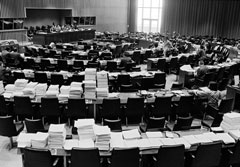 On the initiative of the representative of the Government of Malta, the General Assembly considered at its twenty-second session, in 1967, an item entitled “Examination of the question of the reservation exclusively for peaceful purposes of the seabed and the ocean floor, and the subsoil thereof, underlying the high seas beyond the limits of present national jurisdiction, and the use of their resources in the interests of mankind”. By resolution 2340 (XXII) of 18 December 1967, the Assembly established an Ad Hoc Committee to Study the Peaceful Uses of the Sea-Bed and the Ocean Floor beyond the Limits of National Jurisdiction, consisting of thirty-six Member States. The Ad Hoc Committee was requested to prepare a study, to be presented at the following session of the General Assembly, on the scientific, technical, economic, legal and other aspects of use of the seabed and the ocean floor, including a survey of past and present activities of the United Nations and other intergovernmental organizations in this regard. The Ad Hoc Committee held three sessions during 1968, and presented its study (A/7230) to the General Assembly at its twenty-third session, in 1968. While having carried out a comprehensive study of the various aspects of the item within the limits of the time available, the Ad Hoc Committee recognized the need for further study, and made suggestions for this purpose. Having considered the report, the General Assembly adopted on 21 December 1968 resolution 2467 A (XXIII), by which it decided to establish a Committee on the Peaceful Uses of the Sea-Bed and the Ocean Floor beyond the Limits of National Jurisdiction, consisting of forty-two Member States. The Committee was instructed to study the elaboration of legal principles and norms which would promote international co-operation in the exploration and the use of the seabed and ocean floor, and to make recommendations to the General Assembly thereon. At its subsequent session, the General Assembly, having considered the report of the Committee (A/7622), requested the Secretary-General to ascertain the views of Member States on the desirability of convening, at an early date, a conference on the law of the sea (resolution 2574 A (XXIV) of 15 December 1969). On the initiative of the representative of the Government of Malta, the General Assembly considered at its twenty-second session, in 1967, an item entitled “Examination of the question of the reservation exclusively for peaceful purposes of the seabed and the ocean floor, and the subsoil thereof, underlying the high seas beyond the limits of present national jurisdiction, and the use of their resources in the interests of mankind”. By resolution 2340 (XXII) of 18 December 1967, the Assembly established an Ad Hoc Committee to Study the Peaceful Uses of the Sea-Bed and the Ocean Floor beyond the Limits of National Jurisdiction, consisting of thirty-six Member States. The Ad Hoc Committee was requested to prepare a study, to be presented at the following session of the General Assembly, on the scientific, technical, economic, legal and other aspects of use of the seabed and the ocean floor, including a survey of past and present activities of the United Nations and other intergovernmental organizations in this regard. The Ad Hoc Committee held three sessions during 1968, and presented its study (A/7230) to the General Assembly at its twenty-third session, in 1968. While having carried out a comprehensive study of the various aspects of the item within the limits of the time available, the Ad Hoc Committee recognized the need for further study, and made suggestions for this purpose. Having considered the report, the General Assembly adopted on 21 December 1968 resolution 2467 A (XXIII), by which it decided to establish a Committee on the Peaceful Uses of the Sea-Bed and the Ocean Floor beyond the Limits of National Jurisdiction, consisting of forty-two Member States. The Committee was instructed to study the elaboration of legal principles and norms which would promote international co-operation in the exploration and the use of the seabed and ocean floor, and to make recommendations to the General Assembly thereon. At its subsequent session, the General Assembly, having considered the report of the Committee (A/7622), requested the Secretary-General to ascertain the views of Member States on the desirability of convening, at an early date, a conference on the law of the sea (resolution 2574 A (XXIV) of 15 December 1969).
In the Declaration of Principles Governing the Sea-Bed and the Ocean Floor, and Subsoil Thereof, beyond the Limits of National Jurisdiction (resolution 2749 (XXV) of 17 December 1970), the General Assembly recognized that the existing legal framework did not sufficiently regulate the use of the seabed and ocean floor. Bearing in mind the answers by Governments to the inquiries made by the Secretary-General (report A/7925 and Add. 1-3), the General Assembly decided on the same day, in resolution 2750 C (XXV), to convene a third conference on the law of the sea in 1973, and instructed the Committee on the Peaceful Uses of the Sea-Bed and the Ocean Floor beyond the Limits of National Jurisdiction to act as preparatory body for the conference. The Committee subsequently held six sessions and a number of additional meetings in New York and Geneva between 1971 and 1973. The General Assembly noted the progress in the Committee’s work in resolution 2881 (XXVI) of 21 December 1971, by which it also decided to enlarge the Committee, adding another five members to its membership. On 18 December 1972, having considered the report on the Committee’s work during its 1972 sessions (A/8721 and Corr.1), the General Assembly requested the Secretary-General to convene the first session of the Third United Nations Conference on the Law of the Sea in 1973 to deal with organizational matters, and a second session in 1974, as well as subsequent sessions if necessary, to deal with substantive work (resolution 3029 (XXVII)). The Committee submitted its final report to the General Assembly at its twenty-eighth session, in 1973 (A/9021 and Corr.1 and 3). Having considered the report, the General Assembly requested the Secretary-General to invite States to the Conference, and decided that the mandate of the Conference was the adoption of a Convention dealing with all matters relating to the Law of the Sea (resolution 3067 (XXVIII) of 16 November 1973).
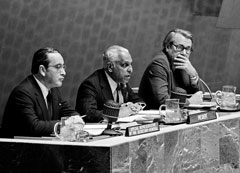 The Conference, in which 160 states participated, held eleven sessions between 1973 and 1982. At the first session, the Conference set up a General Committee, three Main Committees, a Drafting Committee and a Credentials Committee. The Conference allocated to the First Committee the topic of the international regime of the seabed and ocean floor beyond national jurisdiction, and to the Second Committee the topics of the territorial sea, the contiguous zone, the continental shelf, the exclusive economic zone, the high seas, land-locked countries, shelf-locked States and States with narrow shelves or short coastlines and the transmission from the high seas, while the topic of the preservation of the marine environment was allocated to the Third Committee. All the main Committees, as far as the topics were relevant to their mandates, were to deal with regional arrangements, responsibility and liability for damage resulting from the use of the marine environment, settlement of disputes, and the peaceful uses of the ocean space, zones of peace and security. The latter, as well as the topic of enhancing the universal participation of States in multilateral conventions relating to the law of the sea, were to be considered directly by the plenary (see A/CONF.62/29). The following sessions were held by the Conference: The Conference, in which 160 states participated, held eleven sessions between 1973 and 1982. At the first session, the Conference set up a General Committee, three Main Committees, a Drafting Committee and a Credentials Committee. The Conference allocated to the First Committee the topic of the international regime of the seabed and ocean floor beyond national jurisdiction, and to the Second Committee the topics of the territorial sea, the contiguous zone, the continental shelf, the exclusive economic zone, the high seas, land-locked countries, shelf-locked States and States with narrow shelves or short coastlines and the transmission from the high seas, while the topic of the preservation of the marine environment was allocated to the Third Committee. All the main Committees, as far as the topics were relevant to their mandates, were to deal with regional arrangements, responsibility and liability for damage resulting from the use of the marine environment, settlement of disputes, and the peaceful uses of the ocean space, zones of peace and security. The latter, as well as the topic of enhancing the universal participation of States in multilateral conventions relating to the law of the sea, were to be considered directly by the plenary (see A/CONF.62/29). The following sessions were held by the Conference:
| - |
First session held at United Nations Headquarters in New York, 3 to 15 December 1973; |
| - |
Second session held at Parque Central, Caracas, 20 June to 29 August 1974; |
| - |
Third session held at the Office of the United Nations in Geneva, 17 March to 9 May 1975 (General Assembly resolution 3334 (XXIX) of 17 December 1974); |
| - |
Fourth session held at United Nations Headquarters in New York, 15 March to 7 May 1976 (General Assembly resolution 3483 (XXX) of 12 December 1975); |
| - |
Fifth session held at United Nations Headquarters in New York, 2 August to 17 September 1976 (Decision taken at the 69th meeting of the plenary Conference on 7 May 1976. See Official Records of the Third United Nations Conference on the Law of the Sea, vol. V, A/CONF.62/SR.69); |
| - |
Sixth session held at United Nations Headquarters in New York, 23 May to 15 July 1977 (General Assembly resolution 31/63 of 10 December 1976); |
| - |
Seventh session held at the Office of the United Nations in Geneva, 28 March to 19 May 1978 (General Assembly resolution 32/194 of 20 December 1977); |
| - |
Resumed seventh session held at United Nations Headquarters in New York, 21 August to 15 September 1978 (Decision taken at the 106th meeting of the plenary on 19 May 1978. See Official Records of the Third United Nations Conference on the Law of the Sea, vol. IX, A/CONF.62/SR.106); |
| - |
Eighth session held at the Office of the United Nations Headquarters in Geneva, 19 March to 27 April 1979 (General Assembly resolution 33/17 of 10 November 1978); |
| - |
Resumed eighth session held at United Nations Headquarters in New York, 19 July to 24 August 1979 (Decision taken at the 115th meeting of the plenary on 27 April 1979. See Official Records of the United Nations Conference on the Law of the Sea, vol. XI, A/CONF.62/SR.115); |
| - |
Ninth session held at United Nations Headquarters in New York, 3 March to 4 April 1980 (General Assembly resolution 34/20 of 9 November 1979); |
| - |
Resumed ninth session held at the Office of the United Nations in Geneva, 28 July to 29 August 1980 (General Assembly resolution 34/20 of 9 November 1979); |
| - |
Tenth session held at United Nations Headquarters in New York, 9 March to 24 April 1981 (General Assembly resolution 35/116 of 10 December 1980, and decision taken at the 147th meeting of the plenary Conference on 20 April 1981, A/CONF.62/SR.147). |
| - |
Resumed tenth session held at the Office of the United Nations in Geneva, 3 to 28 August 1981 (General Assembly resolution 35/452 of 11 May 1981); |
| - |
Eleventh session held at United Nations Headquarters in New York, 8 March to 30 April 1982 (General Assembly resolution 36/79 of 9 December 1981); |
| - |
Resumed eleventh session held at United Nations Headquarters in New York, 22 to 24 September 1982 (Decision taken at the 182nd meeting of the plenary Conference on 30 April 1982, A/CONF.62/SR.182). |
On 10 December 1982, the Conference adopted the United Nations Convention on the Law of the Sea, containing 320 articles and nine annexes. The Convention was opened for signature, until 9 December 1984, first at the Ministry of Foreign Affairs of Jamaica (from 10 December 1982), and then at United Nations Headquarters in New York (from 1 July 1983).
In 1990, the Secretary-General initiated an informal consultation process with a view to achieve universal participation in the United Nations Convention on the Law of the Sea. While he recommended States to ratify the Convention, he acknowledged that some provisions relating to deep seabed mining had so far hindered some states from doing so. Fifteen meetings were held under the auspices of the Secretary-General between 1990 and 1994. The consultations can be divided into two phases. The first phase was devoted to identification of issues of concern to some States, the approach to be taken in examining them and the search for solutions. During the second phase more precision was given to the results reached so far; additional points were raised for consideration and participants directed their attention to an examination of consolidated texts embodying these solutions and on the procedure by which they might be adopted (See Consultations of the Secretary-General on outstanding issues relating to the deep seabed mining provisions of the United Nations Convention on the Law of the Sea. Report of the Secretary-General, A/48/950 of 9 June 1994, pp. 1-8). A draft resolution was adopted and submitted to the General Assembly for consideration at its forty-eighth session (See ibid., Annex 1). The General Assembly considered the agenda item entitled “The Law of the Sea” in 1993 on 9 December, and in 1994 on 27 and 28 July. By resolution 48/263 of 28 July 1994 the General Assembly adopted the Agreement relating to the implementation of Part XI of the United Nations Convention on the Law of the Sea of 10 December 1982, consisting of ten articles and nine annexes.
The United Nations Convention on the Law of the Sea entered into force twelve months after the deposit of the sixtieth instrument of ratification, on 16 November 1994. The Agreement relating to the implementation of Part XI of the Convention entered into force on 28 July 1996, thirty days after the deposit of the fortieth instrument of ratification.
In accordance with its mandate under Agenda 21, agreed upon at the United Nations Conference on Environment and Development in 1992, the General Assembly decided in resolution 47/192 of 22 December 1992 to convene the United Nations Conference on Straddling Fish Stocks and Highly Migratory Fish Stocks. Six sessions were held between April 1993 and August 1995, which representatives of 140 states participated1. On 4 August 1995 the Conference adopted the United Nations Agreement for the Implementation of the Provisions of the United Nations Convention on the Law of the Sea of 10 December 1982 relating to the Conservation and Management of Straddling Fish Stocks and Highly Migratory Fish Stocks, which was opened for signature until 4 December 1996. The Agreement entered into force on 11 December 2001, thirty days after the deposit of the thirtieth instrument of ratification.
Selected preparatory documents
(in chronological order)
General Assembly Resolution 1307 (XIII) of 10 December 1958 (Convening a second United Nations Conference on the Law of the Sea)
Speech by the Maltese Ambassador to the United Nations on 1 November 1967, 22nd session of the General Assembly (First Committee, 1515th meeting)
General Assembly Resolution 2340 (XXII) of 18 December 1967 (Examination of the question of the reservation exclusively for peaceful purposes of the sea-bed and the ocean floor, and the subsoil thereof, underlying the high seas beyond the limits of present national jurisdiction, and the use of their resources in the interest of mankind)
Report of the Ad Hoc Committee to Study the Peaceful Uses of the Sea-Bed and the Ocean Floor beyond the limits of National Jurisdiction (A/7230, 1968)
General Assembly resolution 2467 A (XXIII) of 21 December 1968 (Examination of the question of the reservation exclusively for peaceful purposes of the sea-bed and the ocean floor, and the subsoil thereof, underlying the high seas beyond the limits of present national jurisdiction, and the use of their resources in the interests of mankind)
Report of the Committee on the Peaceful Uses of the Sea-Bed and the Ocean Floor beyond the Limits of National Jurisdiction to the General Assembly at its twenty-fourth session (A/7622, 1969 and Corr. 1, 30 October 1969 and Add.1, November 1969)
General Assembly resolution 2574 A (XXIV) of 15 December 1969 (Examination of the question of the reservation exclusively for peaceful purposes of the sea-bed and the ocean floor, and the subsoil thereof, underlying the high seas beyond the limits of present national jurisdiction, and the use of their resources in the interests of mankind)
General Assembly Verbatim Records of plenary meeting no. 1933 held on 17 December 1970 (A/25/PV.1933)
General Assembly resolution 2750 C (XXV) of 17 December 1970 (Examination of the question of the reservation exclusively for peaceful purposes of the sea-bed and the ocean floor, and the subsoil thereof, underlying the high seas beyond the limits of present national jurisdiction and the use of their resources in the interests of mankind, and convening of a conference on the law of the sea)
General Assembly resolution 2749 (XXV) of 17 December 1970 (Declaration of Principles Governing the Sea-Bed and the Ocean Floor, and the Subsoil Thereof, beyond the limits of National Jurisdiction)
Report of the Secretary-General on the views of Member States concerning the desirability of convening a United Nations Conference on the Law of the Sea (A/7925, 17 July 1970 and Add. 1-3, 27 August 1970)
General Assembly resolution 2881 (XXVI) of 21 December 1971 (Examination of the question of the reservation exclusively for peaceful purposes of the sea-bed and ocean floor, and the subsoil thereof, underlying the high seas beyond the limits of present national jurisdiction, and the use of their resources in the interests of mankind, and convening of a conference on the law of the sea)
Report of the Committee on the Peaceful Uses of the Sea-Bed and the Ocean Floor beyond the Limits of National Jurisdiction to the General Assembly at its twenty-eighth session (A/8721, 1972 and Corr. 1, November 1972)
General Assembly resolution 3067 (XXVIII) of 16 November 1973 (Examination of the question of the reservation exclusively for peaceful purposes of the sea-bed and the ocean floor, and the subsoil thereof, underlying the high seas beyond the limits of present national jurisdiction, and the use of their resources in the interests of mankind, and convening of the Third United Nations Conference on the Law of the Sea)
Consultations of the Secretary-General on outstanding issues relating to the deep seabed mining provisions of the United Nations Convention on the Law of the Sea. Report of the Secretary-General (A/48/950, 9 June 1994)
Third United Nations Conference on the Law of the Sea Official Records, vols. I-XVII.
Third United Nations Conference on the Law of the Sea Official Records, Vol. III: Documents of the Conference (A/CONF.62/29, 1974)
Draft Convention on the Law of the Sea, Third United Nations Conference on the Law of the Sea Official Records, Vol. XV (A/CONF.62/L.78, 28 August 1981)
Final Act of the Third Conference on the Law of the Sea:
English - Français - Русский - Español
General Assembly resolution 263 of 28 July 1994 (Agreement relating to the implementation of Part XI of the United Nations Convention on the Law of the Sea of 10 December 1982)
العربية - 中文 - English - Français - Русский - Español
General Assembly resolution 47/192 of 22 December 1992 (United Nations Conference on straddling fish stocks and highly migratory fishstocks)
General Assembly, Verbatim Records of plenary meeting No. 72
held on 9 December 1993 (A/48.PV.72)
General Assembly, Verbatim Records of plenary meeting No. 73
held on 9 December 1993 (A/48.PV.73)
General Assembly, Verbatim Records of plenary meeting No. 100
held on 27 July 1994 (A/48/PV.100)
General Assembly, Verbatim Records of plenary meeting No. 101
held on 28 July 1994 (A/48/PV.101)
General Assembly resolution 48/263 of 28 July 1994 (Agreement relating to the implementation of Part XI of the United Nations Convention on the Law of the Sea of 10 December 1982)
Final Act of the United Nations Conference on Straddling Fish Stocks and Highly Migratory Fish Stocks (A/CONF.164/38, 7 September 1995)
For further information and documentation on the United Nations Convention on the Law of the Sea and the United Nations Agreement for the Implementation of the Provisions of the United Nations Convention on the Law of the Sea of 10 December 1982 relating to the Conservation and Management of Straddling Fish Stocks and Highly Migratory Fish Stocks, see the official website of the Division for Ocean Affairs and the Law of the Sea, Office of Legal Affairs, United Nations: http://www.un.org/Depts/los/.
The Convention entered into force on 16 November 1994. For the current participation status of the Convention, as well as information and relevant texts of related treaty actions, such as reservations, declarations, objections, denunciations and notifications, see:
The Status of Multilateral Treaties Deposited with the Secretary-General
The Agreement regarding the Implementation of Part XI of the United Nations Convention on the Law of the Sea of 10 December 1982 entered into force provisionally on 16 November 1994, and definitively on 28 July 1996. For the current participation status of the Agreement, as well as information and relevant texts of related treaty actions, such as reservations, declarations, objections, denunciations and notifications, see:
The Status of Multilateral Treaties Deposited with the Secretary-General
| Statements |
Third United Nations Conference on the Law of the Sea, 1st meeting, United Nations Headquarters, New York, 3 December 1973
Video (12 minutes, Full version) |
 |
 |
Statement by Secretary-General Kurt Waldheim, acting President
Opening of the Conference and election of the President
Video (8 minutes, English) |
 |
Statement by Mr. Hamilton Shirley Amerasinghe (Sri Lanka), elected President
Video (3 minutes, English) |
Third United Nations Conference on the Law of the Sea, Second Session, Caracas, Venezuela, 19 to 28 June 1974
[Minor sound quality problems in the original]
Video (42 minutes, Full version) |
 |
 |
Flag raising and ceremony at the conference site
Video (1 minutes) |
 |
Statement by Mr. Miguel Burelli (Venezuela), President of the Organizing Committee, 19 June 1974
Video (4 minutes, Español) |
 |
Statement by Mr. Constantin Stavropolous, Special Representative of the Secretary-General, 19 June 1974
Video (3 minutes, English) |
 |
Arrival of Mr. Kurt Waldheim, Secretary-General of the United Nations, in Caracas, Venezuella, and Press Conference 19 June 1974
Video (2 minute, Mute)
|
 |
Press conference with Mr. Kurt Waldheim, Secretary-General of the United Nations, 19 June 1974
Video (11 minutes, Español/English) |
 |
Statement by Mr. Carlos Andres Perez, President of Venezuela, 14th plenary meeting, 20 June 1974
Video (1 minute, Español) |
 |
Statements by Mr. Carlos Andres Perez, President of Venezuela, 14th plenary meeting, 20 June 1974 (continued)
Video (6 minutes, Español) |
 |
Statement by Mr. Kurt Waldheim, Secretary-General of the United Nations, 14th plenary meeting, 20 June 1974
Video (3 minutes, Español/English) |
 |
Statement by Mr. Mustafa (Sudan), on behalf of the African Group of States, 14th plenary meeting, 20 June 1974
Video (2 minutes, English) |
 |
Reading of a message from Mr. Richard M. Nixon, President of the United States of America, by Mr. David L. D. Hall, Executive Secretary of the Conference (excerpt), 21st Plenary Meeting, 28 June 1974
Video (40 seconds, English) |
Third United Nations Conference on the Law of the Sea, Caracas, Venezuela, 28 June to 3 July 1974
Video (1 hour, 17 minutes, Full version) |
 |
 |
Excerpt of statement of Mr. Gonzalo Facio (Costa Rica), 21st Plenary Meeting, 28 June 1974
Video (3 minutes, Español) |
 |
Excerpt of statement by Mr. Ramiro Guerriero (Brazil)
21st Plenary Meeting, 28 June 1974
Video (4 minutes, Español) |
 |
Excerpt of Statement by Mr. G. Moe (Barbados)
21st Plenary Meeting, 28 June 1974
Video (2 minutes, English) |
 |
Excerpt of Statement by Mr. Kekoura Camara (Guinea)
21st Plenary Meeting, 28 June 1974
Video (2 minutes, Français) |
 |
Excerpt of statement by Mr. Vu’o’ng’ Van Bac (Republic of Vietnam), 22nd Plenary Meeting, 28 June 1974
Video (2 minutes, Français) |
 |
Excerpt of statement by C. P. Srivastava, Secretary-General of the Inter-Governmental Maritime Consultative Organization, 22nd Plenary Meeting, 28 June 1974
Video (2 minutes, English) |
 |
Excerpt of statement by Mr. Igor Kolosovsky (Union of Soviet Socialist Republics), 22nd Plenary Meeting, 28 June 1974
Video (6 minutes, Русский) |
 |
Excerpt of statement by Mr. Ededin Kazemi (Iran), 23rd Plenary Meeting, 1 July 1974 [Minor sound quality problems in the original]
Video (2 minutes, Français) |
 |
Excerpt of Statement by Mr. Abdel Hamid (Egypt), 23rd Plenary Meeting, 1 July 1974 [Minor sound quality problems in the original]
Video (3 minutes, Français) |
 |
Statement by the President of the Conference, Mr. Hamilton Shirley Amerasinghe (Sri Lanka), speaking in tribute of the death of Juán Domingo Perón, President of Argentina, 24th Plenary Meeting, 1st July 1974
Video (2 minutes, English) |
 |
Excerpt of statement by Mr. Chai Shu-Fan (China), 25th Plenary Meeting, 2 July 1974
Video (2 minutes, 中文) |
 |
Excerpt of statement by Mr. Jens Evensen (Norway), 25th Plenary Meeting, 2 July 1974
Video (1 minute, English) |
 |
Excerpt of statement by Mr. Jack Davis (Canada), 27th Plenary Meeting, 3 July 1974
Video (1 minute, English) |
Third United Nations Conference on the Law of the Sea, Caracas, Venezuela, 29th and 30th Plenary Meeting, 4 July 1974
Video (21 minutes, Full version) |
 |
 |
Excerpt of statement by Mr. Zdenek Pisk (Czechoslovakia), 29th Plenary Meeting, 4 July 1974
Video (56 seconds, English) |
 |
Excerpt of statement by Mr. David Ennals (United Kingdom), 29th Plenary Meeting, 4 July 1974
Video (5 minutes, English) |
 |
Excerpt of statement by Mr. Pelegrin Torras de la Luaz (Cuba), 29th Plenary Meeting, 4 July 1974
Video (5 minutes, Español) |
 |
Excerpt of statement by Mr. Al-Hubaishi (Yemen), 30th Plenary Meeting, 4 July 1974
Video (44 seconds, English) |
Third United Nations Conference on the Law of the Sea, Second Session, 31st and 51st Plenary Meetings, Caracas, Venezuela, 8 July and 28 August 1974
Video (1 hour, 4 minutes, Full version) |
 |
 |
Excerpt of statement by Mr. Strong (United Nations Environment Programme), 31st Plenary Meeting, 8 July 1974
Video (3 minutes, English) |
 |
Excerpt of statement by Mr. Valencia Rodriguez (Ecuador), 31st Plenary Meeting, 8 July 1974
Video (3 minutes, Español) |
 |
Excerpt of statement by Mr. Andersen (Iceland), 31st Plenary Meeting, 8 July 1974
Video (5 minutes, English) |
 |
Excerpt of statement by Mr. Amadou Cissé (Senegal), Chairman of the African Group, 51st Meeting, 28 August 1974
Video (2 minutes, Français) |
 |
Excerpt of Statement by Mr. Arun Panupong (Thailand), Chairman of the Asian Group, 51st Plenary Meeting, 28 August 1974
Video (58 seconds, English) |
 |
Excerpt of Statement by Mr. Zdenek Pisk (Czechoslovakia), Chairman of the Eastern European Group, 51st Plenary Meeting, 28 August 1974
Video (1 minute, English) |
 |
Excerpt of statement by Mr. Galindo Pohl (El Salvador), Chairman of the Latin American Group, 51st Plenary Meeting, 28 August 1974
Video (41 seconds, Español) |
 |
Excerpt of statement by Mr. Abdel Hamid (Egypt), Chairman of the Arab Group, 51st Plenary Meeting, 28 August 1974
Video (1 minute, English) |
 |
Excerpt of statement by Mr. Schacht Aristeguita (Venezuela), 51st Plenary Meeting, 28 August 1974
Video (5 minutes, Español) |
 |
Excerpt of press Conference with Mr. Hamilton Shirley Amerasinghe (Sri Lanka), President of the Conference on the Law of the Sea, August 1974
Video (14 minutes, English) |
 |
Closing statement by the President of the Conference, Mr. Hamilton Shirley Amerasinghe (Sri Lanka), 51st Plenary Meeting, 28 August 1974
Video (6 minutes, English) |
Third United Nations Conference on the Law of the Sea, Fourth Session, 57th Plenary Meeting, United Nations Headquarters, New York, 15 March 1976
Video (16 minutes, Full version) |
 |
 |
Opening statement by Secretary-General Kurt Waldheim, 57th Plenary Meeting
Video (10 minutes, English) |
 |
Excerpt of statement by Mr. Peacock (Australia), Australian Minister of Foreign Affairs
Video (3 minutes, English) |
 |
Excerpt of statement by Mr. Engo (United Republic of Cameroon)
Video (1 minutes, English) |
Third United Nations Conference on the Law of the Sea, Fourth Session, 75th and 76th Plenary Meetings, United Nations Headquarters, New York, 17 September 1976
Video (17 minutes, Full version) |
 |
 |
Excerpt of statement by Mr. Engo (United Republic of Cameroon), Chairman of the First Committee, 75th Plenary Meeting
Video (3 minutes, English) |
 |
Excerpt of statement by Mr. Aguilar (Venezuela), Chairman of the Second Committee, 75th Plenary Meeting
Video (3 minutes, Español) |
 |
Excerpt of statement by the President of the Conference, Mr. Hamilton Shirley Amerasinghe (Sri Lanka), 76th Plenary Meeting
Video (7 minutes, English) |
 |
Excerpt of statement by Secretary-General Kurt Waldheim, 76th Plenary Meeting
Video (2 minutes, English) |
Third United Nations Conference on the Law of the Sea, Fifth Session, 71st and 73rd Plenary Meetings, United Nations Headquarters, New York, 2 August and 13 September 1976
Video (50 minutes, Full version) |
 |
 |
Opening of the Fifth Session of the Conference by the President of the Conference, Mr. Hamilton Shirley Amerasinghe (Sri Lanka), 71st Plenary Meeting, 2 August 1976
Video (4 minutes, English) |
Third United Nations Conference on the Law of the Sea, Sixth Session, 77th and 81st Plenary Meetings, United Nations Headquarters, New York, 23 May and 15 July 1977
Video (22 minutes, Full version) |
 |
 |
Statement by Mr. Hamilton Shirley Amerasinghe (Sri Lanka), President of the Conference, 77th Plenary Meeting, 23 May 1977 Opening of the Sixth Session of the Conference on the Law of the Sea
Video (2 minutes, English) |
 |
Statement by Secretary-General Kurt Waldheim, 77th Plenary Meeting, 23 May 1977
Video (7 minutes, English) |
 |
Excerpt of statement by Mr. Kozyrev (United Soviet Socialist Republics), 77th Plenary Meeting, 23 May 1977
Video (2 minutes, Русский) |
 |
Excerpts of statements by Mr. Hamilton Shirley Amerasinghe (Sri Lanka), President of the Conference, 81st Plenary Meeting, 15 July 1977:Announcement of the result of the vote on the venue for the Seventh Session of the Conference of the Law of the Sea and concluding remarks
[Minor sound quality problems in the original]
Video (5 minutes, English) |
Third United Nations Conference on the Law of the Sea, Eighth Session, Geneva, Switzerland, 19 March 1979
Video (12 minutes, Full version) |
 |
 |
Opening of the Eighth Session of the Conference by the President of the Conference, Mr. Hamilton Shirley Amerasinghe (Sri Lanka), 110th Plenary Meeting
Video (2 minutes, English) |
 |
Interview with Mr. Bernado Zuleta (Colombia), Special Representative of the Secretary-General to the Conference
Video (2 minutes, English) |
Press Conference (excerpts) with Mr. Hamilton Shirley Amerasinghe (Sri Lanka), President of the Conference on the Law of the Sea, Palais des Nations, Geneva, Switzerland, 25 July 1980
Video (12 minutes, Full version) |
 |
Third United Nations Conference on the Law of the Sea, Ninth Session, Geneva, Switzerland, 28 July to 29 August 1980
Video (39 minutes, Full version) |
 |
 |
Opening of the Ninth Session of the Conference by Mr. Hamilton Shirley Amerasinghe (Sri Lanka), President of the Conference, 121st Plenary Meeting, 3 March 1980
Video (2 minutes, English) |
 |
Statement by Mr. E. Wapenyi (Uganda), Chairman of the Group of 77, 130th Plenary Meeting, 28 July 1980
Video (3 minutes, English) |
| |
Excerpts of statements by Mr. Richardson (United States of America), 130th Plenary Meeting, 28 July 1980 |
 |
Video (1 minute, English) |
 |
Video (2 minutes, English) |
|
|
 |
Excerpt of statement by Mr. Orrego Vicuña (Chile), 137th Plenary Meeting, 26 August 1980
Video (2 minutes, Español) |
 |
Excerpt of statement by Mr. Powell-Jones (United Kingdom), 137th Plenary Meeting, 26 August 1980
Video (2 minutes, English) |
 |
Excerpt of statement by Mr. Ognimba (Congo), 138th Plenary Meeting, 26 August 1980
Video (1 minute, Français) |
 |
Excerpt of statement by Mr. Santos (Philippines), 138th Plenary Meeting, 26 August 1980
Video (1 minute, English) |
 |
Excerpt of statement by Mr. Al-Moussa (Kuwait), 138th Plenary Meeting, 26 August 1980
Video (3 minutes, العربية) |
 |
Excerpt of statement by Mr. Nakagawa (Japan), 139th Plenary Meeting, 27 August 1980
Video (1 minute, English) |
 |
Statement by Mr. Nandan (Fiji), 139th Plenary Meeting, 27 August 1980
Video (3 minutes, English) |
 |
Excerpt of statement by Mr. Wapenyi (Uganda), 141st Plenary Meeting, 29 August 1980
Video (44 seconds, English) |
 |
Statement by Mr. Hamilton Shirley Amerasinghe (Sri Lanka), President of the Conference, 141st Plenary Meeting, 29 August 1980
Video (5 minutes, English) |
Third United Nations Conference on the Law of the Sea, Tenth Session, United Nations Headquarters, New York, 9 and 13 March 1981
Video (49 minutes, Full version) |
 |
 |
Tribute to the memory of Mr. Hamilton Shirley Amerasinghe, first President of the Third United Nations Conference on the Law of the Sea, 142rd Plenary Meeting, 9 March 1981
Video (33 seconds, English) |
 |
Opening of the Tenth Session of the Conference by Secretary-General Kurt Waldheim, 142rd Plenary Meeting, 9 March 1981
Video (6 minute, English) |
| |
Excerpt of statement by Mr. T. T. B. Koh (Singapore), President of the Conference,143rd Meeting, 13 March 1981
(6 minutes, English) |
| |
Statement by Secretary-General Kurt Waldheim, 142nd Plenary Meeting, 9 March 1981
(6 minutes, English) |
| |
Excerpt of statement by Mr. Tubman (Liberia), speaking on behalf of the group of African States, 144th Plenary Meeting, 17 March 1981
(43 seconds, English) |
| |
Excerpt of statement by Mr. Abad Santos (Philippines), speaking on behalf of the group of Asian States, 144th Plenary Meeting, 17 March 1981
(2 minutes, English) |
| |
Excerpt of statement by Mr. Yankov (Bulgaria), speaking on behalf of the group of Eastern European States, 144th Plenary Meeting, 17 March 1981
(42 seconds, English) |
| |
Excerpt of statement by Mr. Valencia-Rodríguez (Ecuador), speaking on behalf of the group of the Latin American States, 144th Plenary Meeting, 17 March 1981
(43 seconds, Español) |
| |
Excerpt of statement by Mr. Oxman (United States of America), 144th Plenary Meeting, 17 March 1981
(49 seconds, English) |
| |
Excerpt of statement by Mr. Zuleta (Colombia), Special Representative of the Secretary-General, 144th Plenary Meeting, 17 March 1981
(35 seconds, Español) |
| |
Excerpt of statement by Mr. Pinto (Sri Lanka), 144th Plenary Meeting, 17 March 1981
(2 minutes, English) |
| |
Excerpt of statement by Mr. James L. Malone (United States of America), 145th Plenary Meeting, 17 March 1981
(2 minutes, English) |
| |
Excerpt of statement by Mr. Adio (Nigeria),145th Plenary Meeting, 17 March 1981
(2 minutes, English) |
| |
Excerpt of statement by Mr. Masaninga (Zambia) 145th Meeting, 17 March 1981
(2 minutes, English) |
Press Conference with Mr. James L. Malone (United States of America), Third United Nations Conference on the Law of the Sea, Tenth Session, Geneva, 5 August 1981
Video (11 minutes, Full version) |
 |
Third United Nations Conference on the Law of the Sea, Eleventh Session, 182nd Plenary Meeting, United Nations Headquarters, New York, 30 April 1982: Adoption of the Convention on the Law of the Sea
Video (11 minutes, Full version) |
 |
 |
The President of the Conference, Mr. T. T. B. Koh (Singapore), puts the Convention on the Law of the Sea to the vote and proclaims the results. The Convention is adopted.
Video (2 minutes, English) |
Third United Nations Conference on the Law of the Sea, Eleventh Session, 182nd Plenary Meeting, United Nations Headquarters, New York, 1st May 1982: Press Conferences [Minor sound quality problems in the original]
Video (35 minutes, English) |
 |
 |
Press Conference with Mr. T. T. B. Koh (Singapore), President of the Conference, and Mr. John Alan Beesley (Canada), Chairman of the Drafting Committee
Video (17 minutes, English) |
 |
Press Conference with Mr. James L. Malone (United States of America) and Mr. Leigh S. Ratiner (United States of America)
Video (17 minutes, English) |
| |
|
|
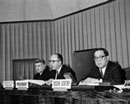 |
 |
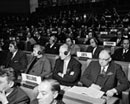 |
 |
17 March 1960
Opening meeting of the Second United Nations Conference on the Law of the Sea, Geneva, Switzerland
[Read more]
|
17 March 1960
Opening meeting of the Second United Nations Conference on the Law of the Sea, Geneva, Switzerland
[Read more] |
17 March 1960
Opening meeting of the Second United Nations Conference on the Law of the Sea, Geneva, Switzerland
[Read more] |
17 March 1960
Opening meeting of the Second United Nations Conference on the Law of the Sea, Geneva, Switzerland
[Read more] |
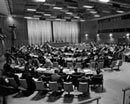 |
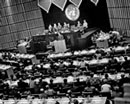 |
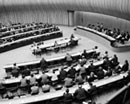 |
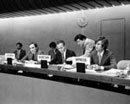 |
13 December 1973
First Session of the Third United Nations Conference on the Law of the Sea,
United Nations Headquarters,
New York
[Read more]
|
20 June 1974
Second Session of Third United Nations Conference on the Law of the Sea, Caracas, Venezuela
[Read more] |
18 March 1975
Third Session of the Third United Nations Conference on the Law of the Sea, opening meeting of the Second Committee, Geneva, Switzerland
[Read more] |
18 March 1975
Third Session of the Third United Nations Conference on the Law of the Sea, opening meeting of the First Committee, Geneva, Switzerland
[Read more] |
 |
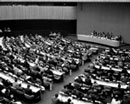 |
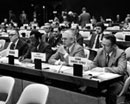 |
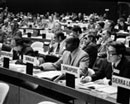 |
18 March 1975
Third Session of the Third United Nations Conference on the Law of the Sea, opening meeting of the Second Committee
[Read more] |
19 March 1975
Third Session of the Third United Nations Conference on the Law of the Sea, first meeting of the Third Committee, Geneva, Switzerland
[Read more]
|
24 March 1975
Third Session of the Third United Nations Conference on the Law of the Sea, meeting of the Second Committee, Geneva, Switzerland
[Read more] |
4 April 1975
Third Session of the Third United Nations Conference on the Law of the Sea, meeting of the Second Committee, Geneva, Switzerland
[Read more] |
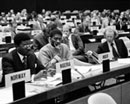 |
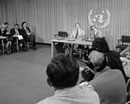 |
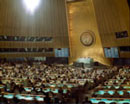 |
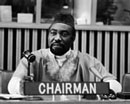 |
4 April 1975
Third Session of the Third United Nations Conference on the Law of the Sea, meeting of the Second Committee, Geneva, Switzerland [Read more] |
8 March 1976
Press Conference by Mr. Jorge Castaneda (Mexico) (left), Chairman of Coastal States Group on Exclusive Economic Zone, before the opening of the Fourth session of the Third United Nations Conference on the Law of the Sea, United Nations Headquarters,
New York
[Read more]
|
15 March 1976
Opening of the Fourth Session of the Third United Nations Conference on the Law of the Sea,
United Nations Headquarters,
New York
[Read more] |
12 April 1976
Fourth Session of the Third United Nations Conference on the Law of the Sea, First Committee,
United Nations Headquarters,
New York
[Read more] |
 |
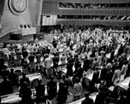 |
 |
 |
17 September 1976
Fifth Session of the Third United Nations Conference on the Law of the Sea,
United Nations Headquarters,
New York
[Read more] |
23 May 1977
Opening of the Sixth Session of the Third United Nations Conference on the Law of the Sea,
United Nations Headquarters,
New York
[Read more]
|
3 March 1980
Opening of the Ninth Session of the Third United Nations Convention on the Law of the Sea,
United Nations Headquarters,
New York
[Read more] |
27 February 1981
Third United Nations Conference on the Law of the Sea, informal meeting of the Drafting Committee, United Nations Headquarters,
New York
[Read more] |
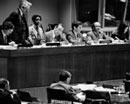 |
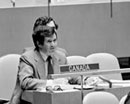 |
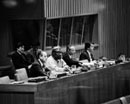 |
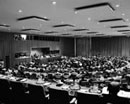 |
27 February 1981
Third United Nations Conference on the Law of the Sea, informal meeting of the Drafting Committee, United Nations Headquarters,
New York
[Read more] |
17 March 1981
Tenth Session of the Third United Nations Conference on the Law of the Sea,
United Nations Headquarters,
New York
[Read more] |
19 March 1981
Tenth Session of the Third United Nations Conference on the Law of the Sea, meeting of the First Committee, United Nations Headquarters,
New York
[Read more]
|
19 March 1981
Tenth Session of the Third United Nations Conference on the Law of the Sea, meeting of the First Committee, United Nations Headquarters,
New York
[Read more] |
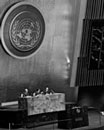 |
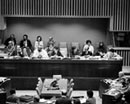 |
 |
 |
8 March 1982
Opening of the Eleventh Session of the Third United Nations Conference on the Law of the Sea, United Nations Headquarters,
New York
[Read more] |
24 September 1982
Resumed Eleventh Session of the Third United Nations Conference on the Law of the Sea, three-day session to prepare the final text of the Convention on the Law of the Sea adopted in April,
United Nations Headquarters,
New York
[Read more]
|
18 March 1983
Accession of Mexico to the Convention on the Law of the Sea, United Nations Headquarters,
New York
[Read more] |
6 December 1994
Forty-ninth Session of the General Assembly, United Nations Headquarters,
New York
[Read more] |
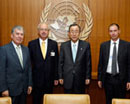 |
|
|
|
14 June 2007
United Nations Headquarters,
New York
[Read more] |
|
|
|
Special Presentation commemorating the 30th anniversary of the
United Nations Convention on the Law of the Sea
This special presentation includes extracts from film footage of the Third United Nations Conference on the Law of the Sea. To view the full version of this footage, as well as other statements, please visit the Historic Archives.
The presentation also contains excerpts from the Audiovisual Library's Lecture Series, which may be viewed through the links below:
Additional lectures on the Law of the Sea may also be viewed through the following links:
Please see the Law of the Sea on the Lecture Series for forthcoming lectures. To be notified when new lectures become available, please subscribe to the RSS feed.
|


 The Third United Nations Conference on the Law of the Sea was convened with a broad agenda including items covering all aspects of the law of the sea, from the traditional ones to the newly emerging ones, such as the common heritage principle, the expansion seawards of the coastal States’ jurisdiction and the protection of the marine environment. After a short procedural session in New York in 1973, the Conference started its substantive work in Caracas in 1974 on the basis of a multi-volume report of the Seabed Committee, without the benefit of the previous work of experts, such as that of the International Law Commission (as in the case of the 1958 Conventions), and without a basic draft. The rule of procedure in fact followed, only in part reflected in the formal rules adopted, was that decisions were to be taken by consensus and that, in order to obtain consensus, a “package deal” approach was to be followed on every issue, on groups of issues and on all issues as a whole. Voting would be admitted only if all efforts at consensus were recognized as being exhausted. This procedure was at the same time necessary and lengthy. It was necessary because of the need to reconcile divergent interests only partially represented by the traditional groups of States (Western industrialized States, Socialist States, Group of 77, etc.), such as those of coastal States, maritime States, archipelagic States, landlocked States, land-based producers of the minerals to be extracted from the nodules, etc. It was lengthy, extending the Conference up to 1982, because it involved the reconciliation of the interests of groups as well as of particular States in such a way that each party involved could perceive even in specific provisions not consonant to its desiderata a part of a package that, as a whole, it could consider to bring more advantages than disadvantages.
The Third United Nations Conference on the Law of the Sea was convened with a broad agenda including items covering all aspects of the law of the sea, from the traditional ones to the newly emerging ones, such as the common heritage principle, the expansion seawards of the coastal States’ jurisdiction and the protection of the marine environment. After a short procedural session in New York in 1973, the Conference started its substantive work in Caracas in 1974 on the basis of a multi-volume report of the Seabed Committee, without the benefit of the previous work of experts, such as that of the International Law Commission (as in the case of the 1958 Conventions), and without a basic draft. The rule of procedure in fact followed, only in part reflected in the formal rules adopted, was that decisions were to be taken by consensus and that, in order to obtain consensus, a “package deal” approach was to be followed on every issue, on groups of issues and on all issues as a whole. Voting would be admitted only if all efforts at consensus were recognized as being exhausted. This procedure was at the same time necessary and lengthy. It was necessary because of the need to reconcile divergent interests only partially represented by the traditional groups of States (Western industrialized States, Socialist States, Group of 77, etc.), such as those of coastal States, maritime States, archipelagic States, landlocked States, land-based producers of the minerals to be extracted from the nodules, etc. It was lengthy, extending the Conference up to 1982, because it involved the reconciliation of the interests of groups as well as of particular States in such a way that each party involved could perceive even in specific provisions not consonant to its desiderata a part of a package that, as a whole, it could consider to bring more advantages than disadvantages.













































